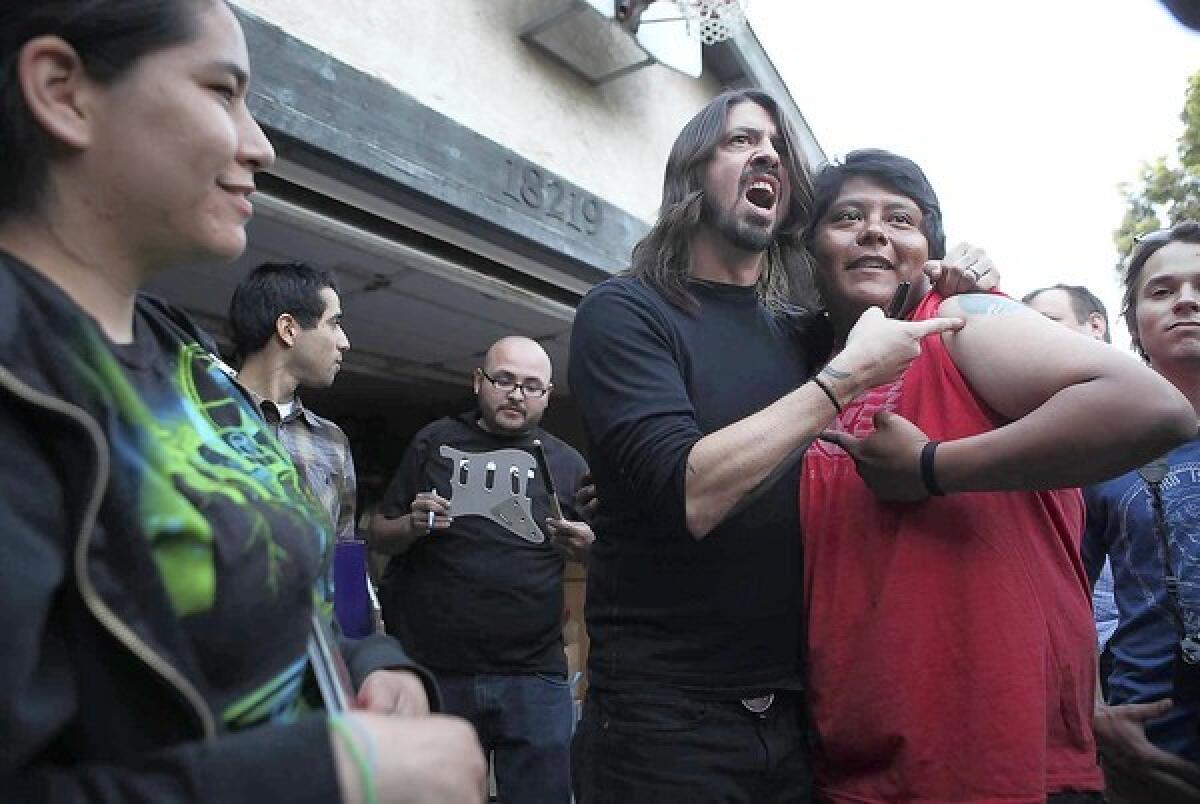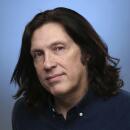Dave Grohl mingles past, present with Foo Fighters

Dave Grohl saw the news online: The famously anti-gay Westboro Baptist Church planned a protest outside a Foo Fighters concert in Kansas City, Mo. The band was another target of the tiny church, which has heckled the funerals of fallen U.S. soldiers, other churches and at least one appliance store. Grohl knew exactly what to do.
Hours before showtime at the city’s Sprint Center arena, the singer-guitarist and the Foos put on fake beards and wigs and rolled out with their instruments on a flatbed truck to deliver a counter-protest. As members of the Kansas-based church watched, the Foo Fighters performed a country tune parody called “Keep It Clean,” mocking the picketers with sexual double-entendres and re-creating the band’s campy “Hot Buns” video, which imagined the showers of an American truck stop as the ultimate homoerotic clubhouse.
“It was a proud moment for the band, to be honest,” Grohl says now, a month later. “It seemed like the right way to deal with them. I didn’t want to ignore them but I also didn’t want to take it too seriously.”
It was a casual demonstration of the resources of a major rock band on the road. The Foos’ current U.S. tour will deliver the group to the Forum in Los Angeles on Oct. 13 and 14, followed by tours of Europe, Australia, Japan — all of it still fueled by the April release of “Wasting Light,” the Foos’ first No. 1 album.
Despite the loud guitars and occasional throat-ripping shrieks, Grohl has been in a contemplative mood lately, openly mingling his past and his present, embracing old ways to make new music. The 11 songs of “Wasting Light” were recorded at home in his Encino garage, using analog tape instead of digital technology. The album also reunited him with Butch Vig, who produced Nirvana’s 1991 grunge milestone “Nevermind,” recorded when Grohl was about to become one of the most acclaimed drummers of his generation. His former Nirvana bandmate, Krist Novoselic, even provides a thundering bass riff cameo on the anguished, raging “I Should Have Known.”
“We did it in my garage with all of our family and friends hanging out the whole time,” Grohl explained to fans from the stage at the Roxy shortly before the release. “We didn’t use computers, we went straight to tape. And because we did it that way, we wound up with … a record that we like to play from beginning to end.”
Not every platinum-selling band is comfortable returning to a smaller scale, bouncing from a 2008 audience of 86,000 at London’s Wembley Stadium to a February warm-up tour of modest club stages across Los Angeles. Or choosing the drywall and aluminum door of a garage over a modern recording studio. “I don’t think the band feels any different than we did in 1995,” Grohl insists. “Our environment has changed, for sure, but when you put the five of us together, I think we still feel most comfortable squeezed in a van or in a tight room rehearsing songs that we’ll eventually play in a stadium.”
The Foos, which along with Grohl, include bassist Nate Mendel, drummer Taylor Hawkins and guitarists Chris Shiflett and Pat Smear, continue to operate as if “Glee” and “American Idol” never happened, a contemporary band fanatical for the rock ‘n’ roll that preceded it, ranging from Motörhead to the pure pop of Paul McCartney & Wings. Beyond the slamdance of the album’s Black Flag-inspired “White Limo” on “Wasting Light” is the whip and snarl of “Miss the Misery,” while “Dear Rosemary” could be an ‘80s Hüsker Dü song, and features that band’s hard-core pioneer Bob Mould on stormy harmony vocals.
The album sound is mostly arena-sized, but fueled on a reconnection with Grohl’s earliest live rock experiences, centered in the D.C. hard-core scene. His first show as a teenager was Naked Raygun, and his life was changed. “The singer jumped on my head, people were spitting, it was loud,” says Grohl, now 42. “And I just thought, ‘Wow, this is rock ‘n’ roll. It’s even better than I imagined it to be. This isn’t like my KISS poster, this is … cooler!’”
As a young producer, Vig first met Grohl in a North Hollywood rehearsal space as Nirvana prepared for the “Nevermind” sessions. “Dave had this great c’est la vie about life, and he still has it,” Vig remembers. “He goes full speed but he is one of the nicest, funniest guys in the world.” They’d kept in touch through the years, and Vig produced two new songs for the band’s 2009 “Greatest Hits” collection.
After that, Grohl talked of doing a full album together. “Then Dave dropped a bomb on me,” Vig says. “He said, ‘I want to do it in my garage.’” Recording in analog was “another bomb” from the chief Foo Fighter, but after a “rocky start” the results became clear to Vig. “It’s the most honest record they’ve done because it’s real, as opposed to being put together in a computer. It sounds like a band playing,” says Vig, who says the experience has already influenced his work recording the next Garbage album.
Working on a full album with Vig — especially with the event of Grohl, Vig and Novoselic recording a song together for the first time since “Nevermind” — meant embracing their history, and acknowledging the Foos’ shared lineage with Nirvana. It comes just as fans celebrate “Nevermind’s” 20th anniversary. It’s a subject Grohl avoided completely in the earliest years of the Foo Fighters, gradually opening up during the last 16 years, now most vividly in “Foo Fighters: Back and Forth,” a feature-length documentary that accompanied the album release.
The film, distributed theatrically and broadcast on VH1, begins with a substantial retelling of the rise and sudden end of Nirvana, the 1994 death of Kurt Cobain, and the subsequent birth of the Foos from a cassette-only release recorded solo by Grohl. “It’s a balance that I have to keep every day. I wouldn’t be here if it weren’t for Nirvana,” Grohl says. “I started the Foo Fighters to heal myself from what had happened to Nirvana. Kurt had died. And we had this beautiful thing that just disappeared in an instant. Of course, everyone wanted to talk to me about it but I couldn’t talk about it. It hurt too much.
“Then after a while those questions disappeared. I’d meet people and they’d say, ‘When did you start the Foo Fighters?’ And I’d say, ‘Well, when Nirvana ended ....’ And they’d say, ‘Wait, you were in Nirvana?’ You don’t know that? Weird!”
More to Read
The biggest entertainment stories
Get our big stories about Hollywood, film, television, music, arts, culture and more right in your inbox as soon as they publish.
You may occasionally receive promotional content from the Los Angeles Times.











